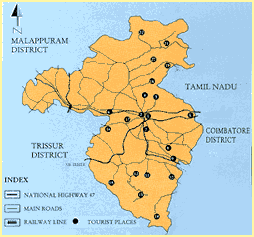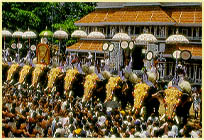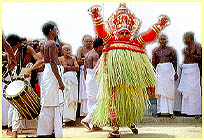 |  |  |  |
Wayanad District, in the north-east of Kerala, India, was formed on November 1, 1980 as the 12th district, carved out of Kozhikode District and Kannur District. Though the word Wayanad is believed by some to have originated from Vayal (paddy) and Naad (land), 'Land of Paddy Fields', some scholars disagree. The region was known as Mayakshetra (Maya's land) in the earliest records. Mayakshetra evolved into Mayanad and finally to Wayanad. There are many indigenous tribals in this area. It is set high on the majestic Western Ghats with altitudes ranging from 700 to 2100 m. The district is going through its worst agrarian crisis. In ancient times the land was ruled by the Vedar Rajas. Later Wayanad came under the rule of Pazhassi Raja of Kurumbranadu Royal Dynasty of Kannur. The modern history of the district is associated with the events that took place during the Mysorean invasion and the long spell of the British rule stretching over a period of about two centuries. There was fierce encounter between the British and the Pazhassi Rajah. When the state of Kerala came into being in 1956, Wayanad was a part of Cannannore district; later in 1957 south Wayanad was added to Kozhikode district and north Wayanad remained with Cannannore district. By amalgamating the north Wayanad and south Wayanad, the present Wayanad district came into being on the 1st November 1980 comprising of three taluks; Vythiry, Mananthavady and Sulthan Bathery.Even GUDALUR was a part of malabar.but the carelessness of the kerala government led to the encrochment of kerala territories.12 villages of kerala was being added to the boundaries of tamilnadu and the reorganisation was not proper.the paniyas and other tribals of this land have their inclination and intrest towards wayand...about 90% of the poPulation here is malayalees where they have been settled for generations,the history of gudalur& pandalur taluk reveals the culture and traditions of this land......even now the tribals consider onam and vishu as their main festivals and to conclude with gudalutaluk should have been a part of Wayanad. Both the govts" must think of this reorganisation immediately. One important characteristic feature of this district is the large adivasi population, consisting mainly of Paniyas, Adiyas, Kattunayakan and Kurichiyans. Wayanad district stands first in the case of adivasi population (about 36%) among other districts in the state. Wayanad has a large settler population. The jains from Karnataka came in the 13th century. The Nairs from Kottayam-Kurumbranadu (not the southern district of kottayam but pazhassi raja's kingdom of Kannur) made an entry in the 14th century and established their feudal life. They were followed by Muslims. There was large scale migrations from southern Kerala in the early 1940s. Their hard work and sacrifice helped them to prosper. On the other hand, the last few decades have seen the complete marginalisation of the indigenous people. Alienated from their land and victimized by the state, their status is a blot on the progressive ideals of Kerala society.Syrian Christians who came in the 1950s from Travancore, were well established as plantation owners until recently when the crash in the price of plantation crops.Chola Naickens,who used to be proud people, were very hospitable to early settlers are now the worst affected, under abject poverty.
Places of Interest.
Mountains
Chembra peak (2345 m), Vellairmala (2145 m), Banasuran mala (2061 m), Elembileri mala (1839 m), Brahmagiri (1608 m), Kunnelipadimala (1607 m), Thariode mala (1553 m) are some of the important mountains in the district.
Rivers
The Kabini River, one of the three east flowing rivers of Kerala, is an important tributary of the Kaveri River. Almost the entire Wayanad district is drained by Kabini and its three tributaries, the Panamaram River, Mananthavady River, and Kalindy River. The Banasura Sagar Dam crosses one of tributaries of the Kabini River.
There are various places of touristic, ecological, religious and historic importance in the district, including:
Thirunelli Temple is a very old temple on the foothills of Brahmagiri which is a Papa Nasini.
Edakkal Caves, 32 km from Kalpetta near Ambalavayal, is famous for its pre-historic carvings and paintings.
Muthanga is a wild life sanctuary. It is on the way from Mysore to Sulthan Bathery. Wild animals such as bison, elephant, deer, and tiger has been spotted. There are also quite a few wild birds in the sanctuary.
There is a famous Jain Temple near Koottamunda, the Ananthanatha Swami Temple.
Pallikunnu Church, 14 km from Kalpetta is a famous Pilgrim centre in north kerala. Pallikunnu Church celebrates the festival on February 10th and 12th every year.
Mazhuvannur Siva Temple is an ancient Shiva temple near Tharuvana.
Karat Siva Temple is a very old temple near Kommayad.
Sulthan Bathery is famous for its fort, which was built by Tipu Sultan.
The tomb of the chieftain Pazhassi Raja, who fought the British with the help of Kurichiya warriors, is in Mananthavady.
Valliyoorkav is a temple of great historic and social significance.
Lakkidi, the entry-point to Wayanad on the road from Kozhikode, receives one of the highest rainfalls in India.
Pookode lake nearby is a famous tourist centre as well.
Tea Estates A ride through the tea estate is also very beautiful.
For the adventorous the Chembra peak and Banasura, both over 2000 m high, provide tough challenges.
Kuruva Dweep (10 km from Mananthavady) is a unique and fragile delta system on the Kabini River.
An important and unusual pilgrim centre for sociologists and educationists is Kanavu a centre for alternative education which help the adivasis (tribals) to adapt to the challenges without losing their cultural moorings.
Ananthanatha Swami Temple, {also known as ParswanathaSwamy Jain Temple at Puliyarmala Jain Temple at Puliyarmala} is a beautiful Jain temple located at Puliyarmala, 6 km from Kalpetta.
Pakshipathalam is a very popular trekking place [7.5 km oneway] in the Kerala-Karnataka border
Soochipara Falls - a lovely waterfall
Chembra peak - A trekking place which is the highest in the south india.
 |  |  |  |














